Presentations & telescopic viewing on Tuesday evening, October 17th, are FREE and open to all.
WASHINGTON, Oct. 6, 2017 — (PRNewswire) — The American Astronomical Society's Division for Planetary Sciences (DPS) invites the public to hear presentations from two award-winning astronomers and then to enjoy telescopic views of celestial wonders. These FREE events are being held on the campus of Brigham Young University (BYU) in connection with the 49th annual DPS meeting ( https://aas.org/meetings/dps49) at the Utah Valley Convention Center in Provo from October 15th through the 20th.
The lectures and star party, which are FREE and open to everyone, will occur at BYU on Tuesday evening, October 17th, with the talks from 7:00 to 8:30 pm in Benson building room W112 followed by telescopic viewing (weather permitting) from 8:30 to 10:00 pm outside the Eyring Science Center. Most faculty and student parking lots are available for general parking in the evening; for more information visit the BYU Campus Map at http://maps.byu.edu and click on "PARKING."
Speaking at BYU are the winners of the DPS's 2017 Carl Sagan Medal for Excellence in Public Communication in Planetary Science: Megan E. Schwamb (Gemini Observatory) and Henry B. Throop (Planetary Science Institute). The DPS is honoring Schwamb for the creation and development of new tools and venues to facilitate planetary science communication. She will present "Exploring Mars with 150,000 Earthlings," describing how she has enlisted citizen scientists to help her team examine by eye images from NASA's Mars Reconnaissance Orbiter to identify interesting wind-blown features on Mars that computers seem unable to find no matter how cleverly they're programmed.
Throop's Sagan medal celebrates his efforts to kindle interest in science around the world, especially in countries where astronomy is rarely taught in school. In his talk at BYU, entitled "One Sky: Astronomy Outreach Across the Developing World," Throop will explain his approach to bridging cultural divides and building scientific awareness among young people in Latin America, southern Africa, and India. His efforts over the last decade have inspired many underserved students to pursue studies and careers not only in astronomy, but also in other sciences.
After the talks, the public is invited to head outside to look through telescopes set up by the knowledgeable skywatchers of the BYU Astronomy Club. Potential observing targets include the Andromeda Galaxy, the Double Cluster in Perseus, and the blue-green planet Uranus. You don't need to own or know how to operate a telescope; all you have to do is show up! Suitable for adults and kids ages 10 and up, this event offers a unique opportunity to explore the universe overhead with astronomers available to answer all your questions.
The AAS DPS offers complimentary press registration to qualified local media representatives who wish to cover the 49th DPS meeting: https://aas.org/meetings/dps49/press-information
The American Astronomical Society, established in 1899 and based in Washington, DC, is the major organization of professional astronomers and planetary scientists in North America. Its membership of about 8,000 also includes physicists, mathematicians, geologists, engineers, and others whose research interests lie within the broad spectrum of subjects now comprising contemporary astronomy. The mission of the AAS is to enhance and share humanity's scientific understanding of the universe.
The Division for Planetary Sciences is the largest subject-specific division within the AAS. Members of the DPS study the bodies of our own solar system, from planets and moons to comets and asteroids, and all other solar-system objects and processes. With the discovery that planets exist around other stars, the DPS expanded its scope to include the study of extrasolar planetary systems as well.
View original content with multimedia: http://www.prnewswire.com/news-releases/public-invited-to-astronomy-talks--star-party-at-brigham-young-university-300532639.html
SOURCE American Astronomical Society
| Contact: |
| American Astronomical Society
Dr. Rick Fienberg, AAS Press Officer, 857-891-5649 Email Contact Kimberly Jenkins, BYU Marketing Manager, 801-422-4022 Email Contact Web: http://www.aas.org |